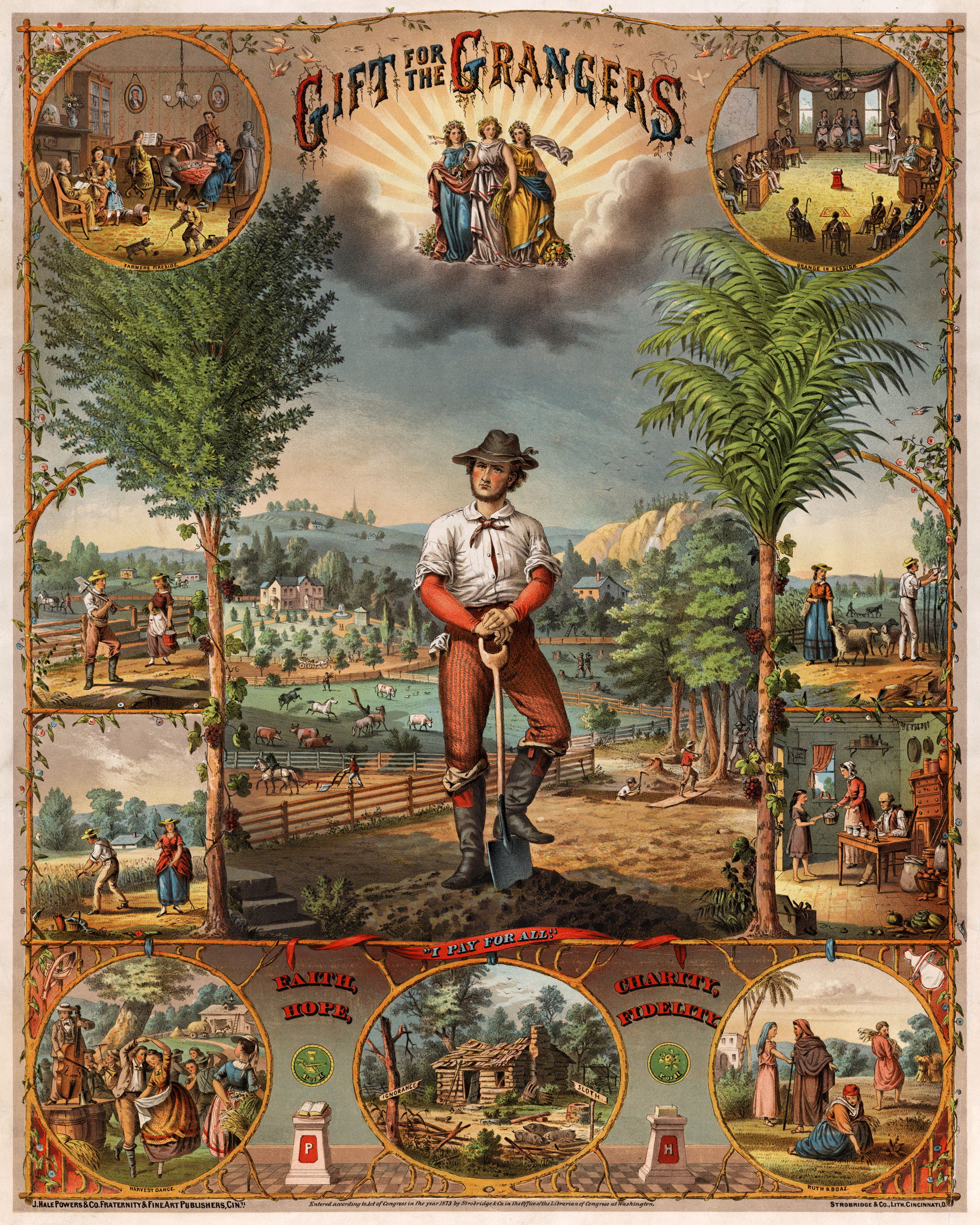The Grange was the first major farm organization and began in the 1860’s. This organization was created mostly as a social and self-help association not originally an organization of protest. During the depression of 1873, this group of bonded friends, became an “agency for political change.” They knew in ordered to help themselves they must become a voice in this new government in order to survive.
With the depression farm product prices began to decrease. More farms joined the Grange to band together to resolve the issues before them.  Beginning as a small group of friends learning from each other what worked and what didn’t, by 1875 the Grange boasted of over 800,000 members and 20,000 local lodges; claiming chapters in almost every state, being the strongest in the states that produced the most: the South and Midwest. As a group (strong in member) they made their statement to the world on an appropriate day, Independence Day 1873. The framers Declaration of Independence informed those listening they were ready to fight back. The Declaration stated they would use “all lawful and peaceful means to free themselves from the tyranny of monopoly”. Many of the members opened stores and other businesses so they could begin to buy and sell to each other. However most of these were farmers, with families, not businessmen and many companies didn’t survive because of their lack of real business knowledge and the pressures of the middlemen who wanted them to fail. They worked as a team to get candidates elected who agreed with the need for governmental control of the railroads. With the control of the Legislatures they implemented governmental controls on railroad rates and practices. However the railroad was also very wealthy. They hired lawyers who soon destroyed the new regulations. With these defeats and with the new rise in farm prices in the late 1870’s the Grange began to lose strength and power, dwindling to a membership to only 100,000 by 1880.
Beginning as a small group of friends learning from each other what worked and what didn’t, by 1875 the Grange boasted of over 800,000 members and 20,000 local lodges; claiming chapters in almost every state, being the strongest in the states that produced the most: the South and Midwest. As a group (strong in member) they made their statement to the world on an appropriate day, Independence Day 1873. The framers Declaration of Independence informed those listening they were ready to fight back. The Declaration stated they would use “all lawful and peaceful means to free themselves from the tyranny of monopoly”. Many of the members opened stores and other businesses so they could begin to buy and sell to each other. However most of these were farmers, with families, not businessmen and many companies didn’t survive because of their lack of real business knowledge and the pressures of the middlemen who wanted them to fail. They worked as a team to get candidates elected who agreed with the need for governmental control of the railroads. With the control of the Legislatures they implemented governmental controls on railroad rates and practices. However the railroad was also very wealthy. They hired lawyers who soon destroyed the new regulations. With these defeats and with the new rise in farm prices in the late 1870’s the Grange began to lose strength and power, dwindling to a membership to only 100,000 by 1880.
The Grange was the springboard for another banding together of farmers, the Farmers Alliances. This new movement began in the Southern states and quickly spread beyond what the Grange had been. One of the most notable differences within the Alliance, was the approval of women to vote and become speakers and leaders for their cause. The Alliance however, had similar problems as the Grange. Many of the cooperations, stores, banks, processing plants and other resources began to suffer the same fate. Lack of solid management and the market forces operating against them caused them to fail. These disappointments aided the forming of a national political organization. This merger held their own national convention in Ocala, Florida in 1889, in which they introduced their Ocala Demands.
Going even further they met and formed a third party. In July 1892, Omaha, Nebraska they met approved an official set of principles and nominated candidates for the presidency and vice presidency. Thus the People’s Party, more often called the Populist Party was born. In the years that soon followed the Populist Party won the elections for Presidency (James B. Weaver of Iowa), three governorships, five senate and ten congressional seats. Also elected were many Republicans and Democrats who sided with the Populists. Most of the Populist leaders were middle class, professional people or long time politicians. Most were not small farmers.
Populism lasted for two decades as a third political party, however it was a losing struggle. One main theory as to their fall was one of the nations leading historians in the 1950s, Richard Hofstadter wrote in his book The Age of Reform published and expounded this view of the Populism group and their likeness to Communism. He stated ” the farmers were very committed to the capitalist system they claimed to abhor.” He stated further that Populism “was permeated with bigotry and ignorance” revealing “anti-Semitic tendencies and their displayed animosity toward intellectuals, easterners, and urbanites.”
What began as a united group of “victims of economically marginal agricultural regions victimized by drought and debt”. The Grangers turned into an organized group who backed many politicians who won and made changes to protect the small farmer, established a network of warehouses were farmers could deposit their crops and use these as collateral for borrowing money from the government at low rates and wait for the price of their crop to increase before selling, and the acceptance of silver as a form of money. Because of these two decades in our history we can see our power to influence and change politics.
